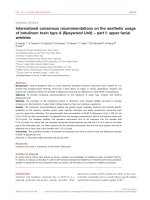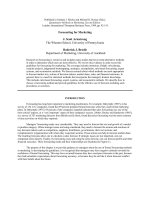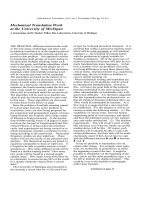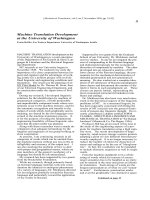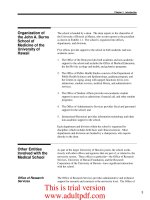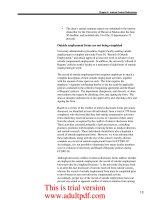the university of Montana a Component unit of the state of Montana_part3 pot
Bạn đang xem bản rút gọn của tài liệu. Xem và tải ngay bản đầy đủ của tài liệu tại đây (275.89 KB, 11 trang )
This is trial version
www.adultpdf.com
The University of Montana
A
Component Unit of the State of Montana
University Component Units
-
Combined Statement of Activities
For the Years Ended June 30 or December 31,2006 and 2005
Temporarily Permanently
2006
Unrestricted Restricted Restricted Total
REVENUES:
Contributions
$
1,514,840
$
16,428,098
$
5,037,433
$
22,980,371
Interest and dividend income
525,727 2,846,679 3,372,406
Net realized and unrealized gain (loss) on investments
36,258 8,424,993 103,665 8,564,9 16
Support received from university
322,800 322,800
Special events
497,163 324,833 240 822,236
Other income
18,867 692,394 711,261
Net assets released from restrictions
20,705,337 (20,705,337)
Total revenues
$23,620,992
$
8,011,660
$
5,141,338
$
36,773,990
EXPENSES:
Program services
Academic and institutional
Capital expenses
Scholarships and awards
4,607,768 4,607,768
Total program services
$
18,245,452
$
-
$
-
$
18,245,452
Operating expenses
Fundraising efforts
General and administrative
Investment management costs
Other miscellaneous
383,190 383,190
Total operating expenses
$
4,478,652
$
-
$
-
$
4,478,652
Change in net assets before nonoperating items
$
896,888
$
8,011,660
$
5,141,338
$
14,049,886
NON-OPERATING REVENUES (EXPENSES):
Payments to beneficiaries and change in liabilities due
to external beneficiaries
(153) (690,413) (690,566)
Adjustments
(5,210) 60,773 (55,563)
Change in net assets
$
891,525
$
7,382,020
$
5,085,775
$
13,359,320
Net assets, beginning of year
9,559,281 56,482,237
87,388,217 153,429,735
Net assets. end of vear
$
10,450,806
$
63,864,257
$
92,473,992 $166,789,055
The accompanying notes are an integral part of these financial statements.
This is trial version
www.adultpdf.com
A-18
The
University of Montana
A
Component Unit of the State of Montana
Consolidated Statements of
Cash
Flows
For the Years Ended June 30,2007 and 2006
2007
2006*
CASH FLOWS FROM OPERATING ACTIVITIES
Student tuition and fees
Federal grants and contracts
State grants and contracts
Nongovernmental grants and contracts
Grant and contract facilities and administrative cost allowances
Sales and services of educational activities
Auxiliary enterprises charges
Interest earned on loans to students
Other operating receipts
Payments to employees for salaries and benefits
Operating expenses
Payments for scholarships and fellowships
Loans made to students
Loan payments received
2,794,572 3,238,467
Net Cash Used
by
Operating Activities
$
(47.387.703)
$
(49.189.353)
CASH FLOWS FROM NONCAPITAL FINANCING ACTIVITIES
State appropriations
$
63,455,247
$
62,073,958
Land Grants
1,505,512 1,452,867
Private Gifts
13,603,340 15,565,3 14
Additions to permanent endowments
1,562,500 1,572,425
Net Cash Provided
by
Noncapital Financing Activities
$
80,126,599
$
80,664,564
CASH FLOWS FROM INVESTING ACTIVITIES
Purchases of investments
$
(1,574,689)
$
(3,638,219)
Proceeds from sales of investments
1,587,772 7,771,747
Earnings received on investments
6,112,05 1 4,845,17 1
Net Cash Provided
by
Investing Activities
$
6,125,134
$
8,978,699
CASH FLOWS FROM CAPITAL AND RELATED FINANCING ACTIVITIES
Cash paid for capital assets
Proceeds from the sale of capital assets
Proceeds from notes payable and advances from primary government
Principal paid on notes payable, advance from primary government, and capital leases
Principal paid on bonds payable
Principal and premium paid to defease revenue bonds
Proceeds from issuance of revenue bonds
Proceeds from
swaption contract
Bond issuance costs paid on new issue
Interest paid on capital debt and leases
(7,469,254) (7,153,560)
Net Cash Used
by
Capital and Related Financing Activities
$
(36,439,696)
$
(13,848,014)
Net Increase in Cash and Cash Equivalents
$
2,424,334
$
26,605,896
Cash and Cash Eauivalents. Beginning of Year
$
84.631.988
$
58.026.092
Cash and Cash Equivalents, End of Year
$
87,056,322
$
84,631,988
*
Restated
The accompanying notes are an integral part of these financial statements.
This is trial version
www.adultpdf.com
The University of Montana
A
Component Unit of the State of Montana
Consolidated Statements
of
Cash Flows
For the Years Ended June 30,2007 and 2006
(Continued)
2007 2006
Reconciliation of Operating Income (Loss) to Net Cash
Provided (Used
By)
Operating Activities:
Operating loss:
$
(65,957,639)
$
(64,642,180)
Adjustments to reconcile operating loss to net cash
used by operating activities
Depreciation and amortization expense 16,842,365 16,710,382
Other amortization expense 335,920 528,415
Changes in assets and liabilities:
Accounts receivable
(1,810,938) (177,425)
Loans to students
562,363 (327,880)
Inventories
(42,443) (28,568)
Prepaid expenses and deferred charges (843,926) (4 1,246)
Accounts payable and accrued expenses 1,264,402 (4,713,024)
Deferred revenue 734,672 1,903,695
Student and other deposits 352,007 295,719
Due to federal government 144,956 179,291
Compensated absences 1,030,558 1,123,468
Net Cash Used
by
Operating Activities
$
(47,387,703)
$
(49,189,353)
Noncash Investing, Noncapital Financing, and Capital
and Related Financing Transactions
Fixed assets acquired by incurring capital lease obligations
$
(86,413)
$
(444,297)
Change in fair value of investments recognized as a component of interest income
1,921,693 339,128
Fixed assets acquired from Capital grants and donations 8,149,640 3,063,893
Reconciliation of Cash and Cash Equivalent to the Statement of Net Assets
Cash and cash equivalents classified as current assets
$
86,849,768
$
84,427,472
Cash and cash equivalents classified as noncurrent assets 206,554
204,s 16
Total Cash and Cash Eauivalents. End of Year
$
87.056.322
$
84.631.988
The accompanying notes are an integral part of these financial statements.
This is trial version
www.adultpdf.com
NOTES TO THE CONSOLIDATED FINANCIAL STATEMENTS
THE UNIVERSITY OF MONTANA
A COMPONENT UNIT OF THE STATE OF MONTANA
FOR
THE
YEARS ENDED JUNE 30,2007 AND 2006
NOTE
1
-
ORGANIZATION, REPORTING ENTITY AND BASIS OF PRESENTATION
ORGANIZATION
The University of Montana (University) is a component unit of the State of Montana (State) with an enrollment of
approximately 18,000 students on its four campuses. The State of Montana Board of Regents (Board of Regents) is
appointed by the Governor of the State and has oversight responsibility with respect to the University. The State
allocates and allots funds to each campus separately and requires that the funds be maintained accordingly.
REPORTING ENTITY
The accompanying consolidated financial statements include all activities of the four campuses of the University, the
Forestry Experiment Station and the Montana Bureau of Mines. The four campuses of the University are The
University of Montana
-
Missoula, Montana Tech of The University of Montana, which is located in Butte, The
University of Montana
-
Western, which is located in Dillon, and The University of Montana
-
Helena College of
Technology.
GASB Statement No. 39, "Determining Whether Certain Organizations Are Component Units, an Amendment of
GASB Statement No. 14" requires that a legally tax exempt organization should be reported as a component unit of a
reporting entity if the economic resources received or held by these organizations are entirely or virtually entirely for
the direct benefit of the reporting entity or its component units, and the reporting entity is entitled to, or has the means
to otherwise access, a majority of the economic resources received or held by the separate organization. The
resources of the separate organization
must also be significant to the reporting entity. The University has established
a threshold
minimum of one percent of consolidated net assets or one percent of consolidated revenues as an
additional requirement for inclusion of an organization as a component unit in its financial statements.
In
addition,
other organizations should be evaluated for inclusion if they are closely related to, or financially integrated with, the
reporting entity. All component units and other related organizations will be tested and evaluated on an annual basis
for inclusion under GASB No.
39.
Accordingly, the University has identified and will present the combined
activities of four component units, The University of Montana Foundation, The Montana Tech Foundation, The
University of Montana
-
Western Foundation, and the Montana Grizzly Scholarship Association. For further
discussion of accounting for component units, see Consolidated Financial Statements Note 19, "Accounting for
Component Units."
The University is considered a component unit of the State of Montana under GASB No. 14. As such,
.the financial
statements for the University are included as a component part of
.the State of Montana Basic Financial Statements,
which are prepared annually and presented in the Montana Comprehensive Annual Financial Report (CAFR).
The University, as a political subdivision of the State of Montana, is excluded from Federal income taxes under
Section
115(1) of the Internal Revenue Code, as amended. Certain activities of the University may be subject to
taxation as unrelated business income under Internal Revenue Code Sections 5
1
1
to
5
14.
BASIS OF PRESENTATION
The financial statements have been prepared in accordance with generally accepted accounting principles, as
prescribed by the Governmental Accounting Standards Board (GASB). Under GASB Statement No. 34, "Basic
Financial Statements and Management Discussion and Analysis for State and Local Governments" and GASB
Statement No. 35, "Basic Financial Statements and Management's Discussion and Analysis for Public Colleges and
Universities," the University is required to present a Statement of Net Assets, a Statement of Revenues, Expenses
This is trial version
www.adultpdf.com
Notes to the Consolidated Financial Statements (continued)
A-21
and Changes in Net Assets, and a Statement of Cash Flows. All significant intra-entity transactions have been
eliminated upon consolidation.
Also, in accordance with GASB Statement No. 39, the combined statement of financial position and statement of
activities of the four component units referred to above are separately presented following the respective University
financial statements.
NOTE
2
-
SUMMARY OF SIGNIFICANT ACCOUNTING POLICIES
BASIS OF ACCOUNTING
For financial reporting purposes, the University is considered a special-purpose government engaged only in
business-type activities. Business-type activities are those that are financed in whole or in part by fees charged to
external parties for goods or services. Accordingly, the University's consolidated financial statements have been
prepared using the economic resources measurement focus and the accrual basis of accounting. Under the accrual
basis, revenues are recognized when earned, and expenses are recorded when an obligation has been incurred.
The University had the option to apply all Financial Accounting Standards Board (FASB) pronouncements issued
after November
30,
1989, unless FASB conflicts with GASB.
The University elected to not apply FASB
pronouncements issued
after the applicable date.
USE OF ESTIMATES
The preparation of financial statements in conformity with generally accepted accounting principles requires
management to make estimates and
assun~ptions that affect the reported amounts of assets and liabilities and the
disclosure of contingent assets and liabilities at the date of the financial statements, and the reported amounts of
revenues and expenses during the reporting period. Actual results may differ from these estimates.
CASH EQUIVALENTS
For purposes of the Consolidated Statement of Cash Flows, the University considers all highly liquid investments
purchased with an original maturity of three months or less to be cash equivalents. Funds invested in Guaranteed
Investment Contracts
(GICs) and in the Short Term Investment Pool (STIP) with the Montana Board of Investments
are considered cash equivalents.
=
INVESTMENTS
The University accounts for its investments at fair value in accordance with GASB Statement No. 31,
"Accounting and Financial Reporting for Certain Investments and for External Investment
Pools." Investment
income is recorded on the accrual basis. All investment income, including changes in unrealized gain (loss) on
the carrying value of investments, is reported as a component of investment income.
ACCOUNTS AND GRANTS RECEIVABLE
Accounts receivable consists of tuition and fee charges to students and to auxiliary enterprise services provided to
students, faculty and staff. Accounts receivable also includes amounts due from the federal government and local
governments, or private sources, in connection with reimbursement of allowable expenditures made pursuant to the
University's grants and contracts. Accounts receivable is recorded net of estimated uncollectible amounts.
INVENTORIES
Inventories are comprised of consumable supplies, food items and items held for resale or recharge within the
University. The larger inventories are valued using the moving-average method. Other inventories are valued using
First In First Out (FIFO) or specific identification methods.
CASH
AND
SHORT-TERM INVESTMENTS
Cash and investments that are externally restricted to make debt service payments, or by a donor or outside agency
prohibiting the expenditure of principal and possibly earnings, are classified as non-current assets in the
Consolidated Statement of Net Assets.
This is trial version
www.adultpdf.com
Notes to the Consolidated Financial Statements (continued)
A-22
CAPITAL ASSETS
Capital assets are stated at cost or fair market value at date of purchase or donation. Renovations to buildings,
infrastructure, and land improvements that significantly increase the value or extend the useful life of the asset are
capitalized. Routine repairs and maintenance are charged to operating expense in the year in which the expense was
incurred. Buildings, building improvements and land improvements, and infrastructure are capitalized when
acquisition costs equal or exceed $25,000 and $500,000, respectively. Equipment is capitalized when acquisition
costs equal or exceed $5,000.
Depreciation is computed on a straight-line basis over the estimated useful lives of the respective assets as follows:
buildings
-
40 years; land improvements and infrastructure
-
20 and 40 years, respectively; library books
-
8
years;
and equipment-
3
to 10 years. Historically, the University has capitalized all artwork subject to applicable
capitalization policies at the time of donation or purchase. The University has elected to continue to capitalize artwork
subject to the current threshold, but without recording depreciation on those items.
DEFERRED REVENUE
Deferred revenues include amounts received for tuition and fees and certain auxiliary activities prior to the end of the
fiscal year but related to the subsequent accounting period. Deferred revenues also include amounts received from
grant and contract sponsors that have not yet been earned.
COMPENSATED LEAVE
Eligible University employees earn eight hours sick leave and ten hours annual leave for each month worked. The
accrual rate for annual leave increases with length of service. The maximum annual leave that eligible employees
may accumulate is two hundred percent of their annual accrual. Sick leave may accumulate without limitation.
Twenty-five percent of accumulated sick leave earned after July
1,
1971, and one hundred percent of accumulated
annual leave, if not used during employment, is paid upon termination.
NET ASSETS
The University's net assets are categorized as follows:
Invested in capital assets, net of related debt
-
Capital assets, net of accumulated depreciation and
outstanding principal balances of debt attributable to the acquisition, construction or improvement of
those assets.
Restricted, nonexpendable
-
Net assets subject to externally imposed stipulations that the University
maintain those assets permanently. Such assets include the University's permanent endowment funds.
Restricted, expendable
-
Net assets whose use by the University is subject to externally imposed
stipulations that can be fulfilled by actions of the University pursuant to those stipulations or that expire
by the passage of time.
Unrestricted
-
Net assets that are not subject to externally imposed stipulations. Unrestricted net assets
may be designated for specific purposes by action of management or the Board of Regents, or may
otherwise be limited by contractual agreements with outside parties. Substantially all unrestricted net
assets are designated for academic and research programs and initiatives, and capital programs.
CLASSIFICATION OF REVENUES
The University has classified its revenues as either operating or non-operating revenues according to the following
criteria:
Operating revenue
-
Operating revenues include activities that have the characteristics of exchange
transactions, such as
(1)
student tuition and fees, net of scholarship discounts and allowances, (2) sales
and services of auxiliary enterprises, net of scholarship discounts and allowances,
(3)
most federal, state
and local grants and contracts and federal appropriations, and (4) interest on institutional student loans.
Non-operating revenues
-
Non-operating revenues include activities that have the characteristics of
non-exchange transactions, such as
gifts and contributions, and other revenue sources that are defined as
non-operating revenues by GASB No. 9, "Reporting Cash Flows of Proprietary and Nonexpendable
Trust Funds and Governmental Entities That Use Proprietary Fund Accounting," and GASB No. 34,
This is trial version
www.adultpdf.com
Notes to the Consolidated Financial Statements (continued)
"Basic Financial Statements and Management Discussion and Analysis for State and Local
Governments." Types of revenue sources that fall into this classification are state appropriations and
investment income.
USE OF RESTRICTED REVENUES
When the University maintains both restricted and unrestricted funds for the same purpose, the order of use of such
funds is determined on a case-by-case basis. Restricted funds remain classified as restricted until they have been
expended.
SCHOLARSHIP DISCOUNTS
AND
ALLOWANCES
Student tuition and fee revenues, and certain other revenues from students, are reported net of scholarship discounts
and allowances in the Statements of Revenues, Expenses, and Changes in Net Assets. Scholarship discounts and
allowances are generated by the difference between the stated charge for goods and services provided by the
University, and the amount that is paid by students and/or third parties making payments on the students' behalf.
Certain governmental grants, such as
Pell grants, and other federal, state or nongovernmental programs, are recorded
as either operating or non-operating revenues in the University's consolidated financial statements. To the extent that
revenues from such programs are used to
satis3 tuition and fees and other student charges, the University has
recorded a scholarship discount and allowance.
RECLASSIFICATION
AND
RESTATEMENT
In order to make certain prior year amounts comparable to the current year presentation on the Consolidated
Statement of Revenues, Expenses and Changes in Net Assets, graduation teaching assistant fee waivers of
$3,726,071 were reclassified to compensation and employee benefits from scholarships and fellowships. The
change in classification of these expenditures also required a reduction of $3,126,232 to the tuition discounting
amount previously reported. The cash flows from operating activities in the Consolidated Statement of Cash Flows
for the prior year was adjusted accordingly to reflect the reclassification and restatement described above.
NOTE 3
-
CASH EQUIVALENTS AND INVESTMENTS
CASH EQUIVALENTS
Cash equivalents consist of cash invested in Guaranteed Investment Contracts (GICs) with Transamerica Occidental,
and in the STIP with the Montana Board of Investments. Amounts held in cash equivalents at June 30, 2007 and
2006 were $57,006,960 and $55,095,471 respectively. At June 30,2007, $17,111,852 of unexpended proceeds from
the issuance of Facility Improvement Revenue Bonds, were invested in GIC accounts and is included in the total
cash equivalents of $57,006,690. STIP investments are purchased in accordance with the statutorily mandated
"Prudent Expert Principle." The STIP portfolio may include asset-backed securities, commercial paper, corporate
and government securities, repurchase agreements and variable rate, or floating rate, instruments to provide
diversification and a competitive rate of return. Investments in STIP and GICs may be withdrawn by the University
on demand, and as such, are classified as cash equivalents.
INVESTMENTS
Investments consisted of the following at June 30,2007 and 2006:
Effective Credit Quality
Duration at Rating at June
Fair Value June 30,2007"
30,2007***
Security Type 2007 2006
U.S.
Government Indirect
-
Backed
$
2,056,148
$
3,350,033 1.697 N/ A
U.S.
Government Direct
-
Backed
2 19,292
Trust Fund Bond Pool (TFBP) 5,727,734 5,507,471
5.25** NR
Montana Domestic Equity Pool (MDEP) 1,3 18,308 1,110,293 Not Applicable
N/ A
Foundation Pooled Investments 17,802,727 14,626,407 Not Applicable
N/
A
Certificates of Deposits 270,530 258,342
.939 N/
A
Total investments
$
27,175,447
$
25,266,838
Securities Lending Collateral Investment
Pool
317,923
$
836,492
This is trial version
www.adultpdf.com
Notes to the Consolidated Financial Statements (continued)
A-24
*See Interest Rate Risk under the Investment Risks disclosure included in this note.
**Effective duration for the Trust Fund Bond Pool (TFBP) is for the entire portfolio. The University's ownership
represents less than 0.5% of the portfolio
***NR indicates security investment unrated for credit quality type.
Investments held by the University at June 30,2007 and 2006 are described further in the paragraphs below.
U.S. Government Securities
U.S. Government securities consist of bond trustee funds managed by U.S. Bank. The U.S. Government securities
portfolio includes Treasury securities or other Federal agency securities, and federal money market accounts. All of
the securities were registered under the nominee's name (U.S. Bank) on behalf of the University.
Montana Board of Investments Pools
The University is a participant in certain internal investment pools administered by the Montana Board of Investments
(MBOI).
MBOI purchases investments for each portfolio in accordance with the statutorily mandated "Prudent Expert
Principle." The University was invested in the following internal investment pools at June 30,2007 and 2006:
Montana Domestic Eguitv Pool MDEP)
The MDEP portfolio may include common stock, equity index, preferred stock, convertible equity
securities, American Depositary Receipts
(ADR's) and equity derivatives. ADR's are receipts issued by a
U.S. depositary bank representing shares of a foreign stock or bonds held abroad by the foreign sub-
custodian of the American depositary bank. Equity derivatives "derive" their value from other equity
instruments such as futures and options.
Trust Funds Bond Pool (TFBP)
The TFBP portfolio includes corporate asset-backed, other corporate, U.S. government mortgage-backed,
and Yankee securities. The TFBP portfolio includes securities classified as corporate, foreign government
bonds, municipals, U.S. government direct-backed, U.S. government indirect-backed, and cash equivalents.
U.S. government direct-backed securities include direct obligations of the U.S. Treasury and obligations
explicitly guaranteed by the U.S. government. U.S. government indirect-backed obligations include U.S.
government agency and mortgage-backed securities. U.S. government mortgage-backed securities reflect
participation in a pool of residential mortgages.
The TFBP portfolio includes structured financial instruments known as
REMICs (Real Estate Mortgage
Investment Conduits).
REMICs are pass-through vehicles for multiclass mortgage-backed securities.
The University Foundation Pools
This pool consists of endowment hnds held in a common investment pool administered by the University of
Montana and Montana Tech Foundations.
Certificates of deposit
Certificates of deposit serve as collateral for loans made to students with disabilities for the purchase of specialized
equipment necessary to complete their education. The certificate of deposit, including interest earned, is reinvested
upon maturity.
Securities lending transactions
Under the provisions of state statutes, the Board of Investments, via a Securities Lending Authorization Agreement,
has authorized the custodial bank, State Street Bank
and Trust, to lend the Board of Investment's securities to
broker-dealers and other entities with a simultaneous agreement to return the collateral for the same securities in the
future. During the period the securities are on loan, the Board of Investments receives a fee and the custodial bank
must initially receive collateral equal to 102 percent of the market value of the loaned securities and maintain
collateral equal to not less than 100 percent of the market value of the loaned security. The Board of Investments
retains all rights and risks of ownership during the loan period.
This is trial version
www.adultpdf.com
Notes to the Consolidated Financial Statements (continued)
A-25
During the years ending June 30,2007 and 2006, the Board of Investments and the borrowers maintained the right to
terminate all securities lending transactions on demand. The cash collateral received on each loan was invested,
together with the cash collateral of other qualified-plan lenders, in a collective investment pool, the Securities
Lending Quality Trust. The relationship between the average maturities of the investment pool and the Board of
Investment's loans was affected by the maturities of the loans made by other plan entities that invested cash
collateral in the collective investment pool, which the Board of Investments could not determine. At June 30, 2007
and 2006, the Board of Investments had no credit risk exposure to borrowers.
Investment risks
Effective June 30, 2005, the University implemented the provisions of Governmental Accounting Standards Board
(GASB) Statement No. 40, "Deposit and Investment Risk Disclosures."
Investment risks associated with
the University's investments are described in the following paragraphs:
Interest Rate Risk
Interest rate risk is the risk that changes in interest rates will adversely affect the fair value of an investment.
In accordance with GASB Statement No. 40, the State of Montana has selected the effective duration
method to disclose interest rate risk. Duration is a measure of a debt's exposure to fair value changes
from
changing interest rates. It uses the present value of the cash flows from the investment, weighting those
cash flows as a percentage of the investment's full price. The University does not have a formal investment
policy for interest rate risk.
Credit Risk
Credit risk is defined as the risk that an issuer or other counterparty to an investment will not fulfill its
obligation. The University does not have a formal investment
poiicy for credit risk. With the exception of
the U.S. government securities, all STIP securities and TFBP fixed income instruments have credit risk as
measured by major credit rating services.
U.S. government securities are guaranteed directly or indirectly by the U.S. government. Obligations of the
U.S. government or obligations explicitly guaranteed by the U.S. government are not considered to have
credit risk and do not require disclosure of credit quality.
Custodial Credit Risk
Custodial credit risk for investments is the risk that, in the event of the failure of the counterparty to
a
transaction, a government will not be able to recover the value of the investment or collateral securities
that are in the possession of an outside party. The University does not have a formal investment policy
for custodial credit risk. As of June
30,
2007 and 2006, all STIP, MDEP and TFBP securities were
registered in the nominee name for the MBOI and held in the possession of the Board's custodial bank,
State Street Bank.
Concentration of Credit Risk
Concentration of credit risk is the risk of loss attributed to the magnitude of a government's investment in a
single issuer.
The University does not have a formal policy for concentration of credit risk. Investments
issued or explicitly guaranteed by the U.S. government are excluded from the concentration of credit risk
requirement. MDEP investments in pooled investments, such as the BGI Equity Index and DFA Small Cap
Subtrust investments, are also excluded from this requirement.
This is trial version
www.adultpdf.com
Notes to the Consolidated Financial Statements (continued)
A-26
Land grant earnines
In 1881, the Congress if the United States granted land to the State of Montana for the benefit of the state's
universities and
colleges. The Enabling Act of 1889 granted 46,563 acres to Missoula, 100,000 acres to Montana
Tech and 50,000 acres to Western Montana College. Under provisions of the grants, proceeds from the sale of land
and land assets, together with proceeds from the sale of timber, oil royalties and other minerals, must be reinvested,
and constitute, along with the balance of unsold land, a perpetual trust
fund. The grant is administered as a trust by
the State Land Board, which holds title and has the authority to direct, control, lease, exchange and sell these lands.
The University, as a beneficiary, does not have title to the assets resulting from the grant, only a right to the earnings
generated. The University's share of the trust earnings was $1,505,512 and $1,452,867 for the years ended June 30,
2007 and 2006, respectively. These earnings are currently pledged to the Series C 1995, Series
E
1998, Series F
1999, Series G 2002, Series
H
2003, Series
I
2004, and Series
J
2005 revenue bonds.
The University's land grant assets are not reflected in the consolidated financial statements, but are included as a
component of the State of Montana Basic Financial Statements that are prepared annually and presented in the
Montana Comprehensive Annual Financial Report (CAFR).
NOTE
4
-
ACCOUNTS
AND
GRANTS RECEIVABLE
Accounts Receivable consisted of the following at June 30,2007 and 2006:
Student tuition and fees
Auxiliary enterprises and other operating activities
Private grants and contracts
Other
Less: allowance for doubtful accounts
333,723 208,356
$
5,672,296
$
4,452,194
NOTE
5
-
LOANS RECEIVABLE
Student loans made under the Federal Perkins Loan Program constitute the majority of the University's loan
receivable balances. Included in non-current liabilities as of June 30, 2007 and 2006 are $10,020,616 and
9,875,660, respectively, that would be
rehndable to the Federal Government should the University choose to
cease participation in the Federal
Perkins Loan program.
The Federal portion of interest income and loan program expenses is shown as additions to and deductions from
the amount due to the Federal government, and not as operating transactions, in the Consolidated Statement of
Net Assets.
NOTE
6
-
INVENTORIES
Inventories consisted of the following at June 30,2007 and 2006:
Bookstore
Food services
Facilities services
Other
This is trial version
www.adultpdf.com

